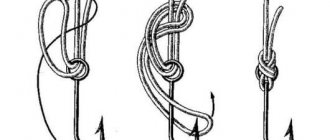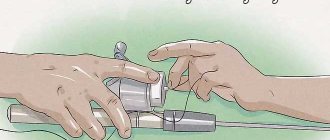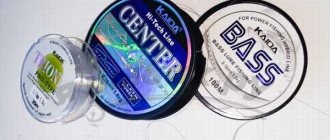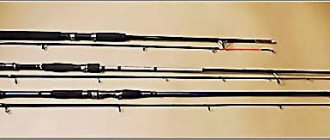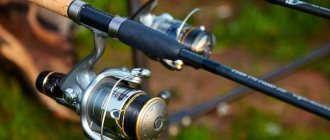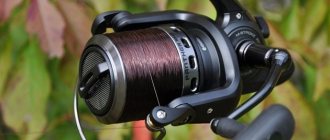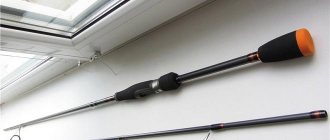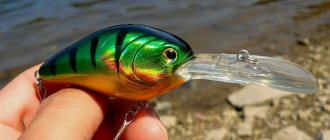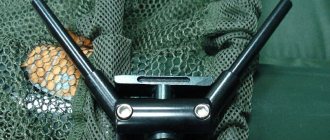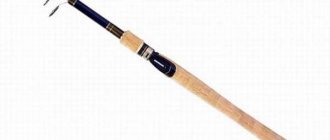No spinning equipment is complete without fishing line. Successful fishing depends on its correct choice.
Before purchasing a fishing line, it is advisable to study the features of a particular fishing line, its characteristics and purpose. Only in this case, while fishing, you won’t have to worry about cliffs, or wonder why there’s no bite. Our review of how to choose the right fishing line for a spinning rod.
Uni-LINE spinning line
In fact, this question is not as simple as it might seem, because the variety of fishing lines today allows you to choose from dozens of options.
Line color
Based on numerous studies, it was concluded that the color of the fishing thread is not of fundamental importance for spinning fishing. An important selection criterion remains maximum strength with a minimum cross-section. These are the factors that have a direct impact on the performance of the bait and the effectiveness of the entire event.
To control movement during the fishing process, you can use a fluorescent vein with a glow effect.
Modern products produced by leading manufacturers have a fairly diverse color palette, where you can choose the best option for specific fishing conditions. Most often, experienced spinning players prefer to choose lighter colors that are less noticeable against the sky.
How to choose fishing line by color
Fishing lines are sold in various shades and colors. But in the vast majority of cases they are made transparent. Also today there are fishing lines with rainbow colors (for every half meter or meter of this fishing line its color will change from one to another). Rainbow fishing line turns out to be indispensable and very convenient when, at the fishing site, you need to quickly match it to the color of underwater grass or the bottom of a reservoir.
You can’t help but pay attention to the color of the fishing line. In some cases, when you plan to fish in grassy areas, it is advisable to give preference to fishing lines painted in various shades of green. When fishing near the bottom - brown, in other cases it is best to use colorless fishing lines. It is quite natural that the color of the leash must fully match the color of the chosen fishing line. Recently, fluorescent fishing lines in light green and light blue colors have become increasingly popular. Their advantage is that they are maximally visible to fishermen and completely invisible to fish.
Thickness
The question of diameter has far from a clear answer; there are a huge number of opinions on this matter. But the fact that it should be both strong and thin thread is supported by all anglers.
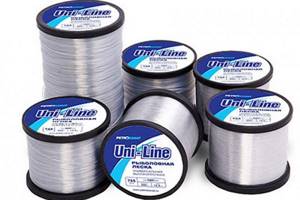
Unlike a float fishing rod, where the tackle is equipped with a thinner fishing line in order to increase the number of bites, the situation with a spinning rod is completely different: here the object of fishing does not have time to examine the thread before throwing, and even grabs it with his teeth and even feels it.
Thickness has a significant impact on casting distance, especially in combination with an inertia-free reel.
When choosing a thread, you need to be guided by the following rule: a sensitive rod and an easily adjustable reel will work effectively with thin and strong fishing line.
The main parameters depend on the weight of the bait and the type of reel:
- a diameter of 0.35 – 0.4 mm goes well with inertial (including multiplier versions) reels;
- diameter 0.25 – 0.27 mm is suitable for inertia-free reels.
Considering that the tackle will be cast over long distances (extra-long distances), and the fishing line will be subject to large dynamic loads, the likelihood of the thread breaking at the moment of a power cast (for example, when catching an asp) increases, and not when landing the prey on the shore. Therefore, it is more advisable to choose the diameter for a spinning rod in accordance with the weight of a particular bait in order to avoid overweight.
You should know that the fishing line wears out from frequent casting; alternatively (more rationally), it can be replaced with a simplified brand, but of domestic production.
Often, thrifty fishermen use the following technique: after fishing, the fishing line needs to be rewound at the other end, and after the next hunt for a predator, remove it completely and put in a new one. This is explained by the loss of strength after the next catch; even a braided cord is not immune from this.
The best fishing line for spinning
There is no clear answer to the question of which thread is better. In almost all cases, braid will be out of competition, as it provides long casts and maximum sensitivity.
Monofilament is used mainly when fishing with cheap gear and in ultralight. The use of fluorocarbon as the main fishing line is justified when catching cautious fish, fish with good eyesight, or those that behave actively and playfully when playing, making powerful sharp jerks - chub, perch, trout, and so on.
Rating of fishing lines for spinning rods
Strike Pro General Line Blue

This is a monofilament from a well-known manufacturer of inexpensive but high-quality fishing products, which was designed specifically for spinning fishing. It is distinguished by its softness and smoothness, while the modern HMV coating protects it from abrasion and exposure to sunlight. Compared to other brands, monofila has low elongation and high sensitivity.
Allvega Bullit Braid Hi-Vis
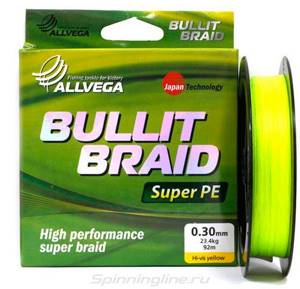
Bullit Braid cords have earned recognition from many anglers due to the combination of an attractive price and good performance. They differ from others in their good abrasion resistance, smooth surface and low hygroscopicity, and have almost no memory.
Varivas High Grade PE
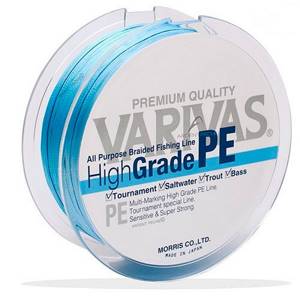
This inexpensive braided thread from Varivas, like all other cords from the Japanese company, has excellent performance characteristics, including high abrasion resistance and strength. Fifty-centimeter marks are applied to it every 25 meters, with the help of which it is very convenient to control the distance to the bait.
Spiderwire Stealth Glow-Vis Braid
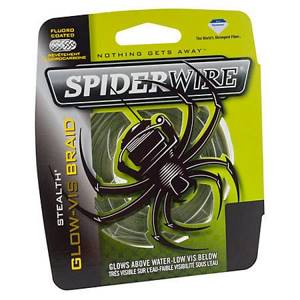
High-quality braid from a renowned manufacturer, which differs from others primarily in its small diameter with the same breaking load, high abrasion resistance and durability.
Yoshi Onyx Drake Fluoro
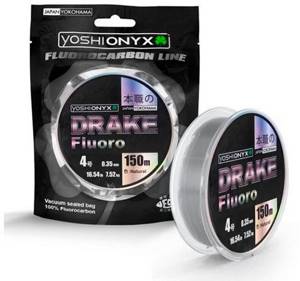
Drake Fluoro is good quality fluorocarbon at a very attractive price. It is soft and slippery, highly durable and has maximum abrasion resistance.
Main line and leader
For the main one, a high-quality braided cord is best suited, the performance characteristics of which are significantly superior to the rest of its counterparts. In second place is monofilament fishing line, due to its high elongation.
To improve the quality of the bite, the tip of the rod should be equipped with a thread with minimal, one might even say zero, stretch.
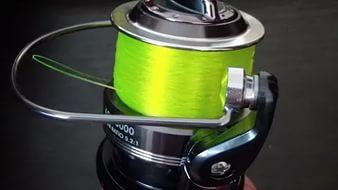
To disguise the main one, leashes made of monofilament and fluorocarbon are used. There are also special leashes designed to hold high loads from the teeth of pike and pike perch: a metal braided leash, soft leash material, a thin string from a musical instrument.
Spinning lines are classified according to:
- thickness;
- coloration;
- breaking capacity;
- manufacturing material.
Currently, the following types of fishing threads are considered equally effective:
- monofilament line (monofilament line);
- braid (braided cord);
- fluorocarbon (fluorocarbon thread).
Each type has both positive and negative qualities. You need to select a certain type of thread taking into account your specific fishing.
Monofilament line
Initially, anglers used monofilament to equip spinning tackle; it was a priority due to its exceptionally smooth surface.
This quality made it possible to pass through the tool’s passage rings with minimal friction, which contributed to the casting distance of the bait, regardless of its shape and weight.
Another useful property of monofilament is its low resistance to water flow, which makes it possible to carry light baits almost to the very bottom. The beneficial properties of monofilament are best demonstrated when fishing with a spinning rod with 5 g of dough.
Advantages:
- has a low coefficient of friction;
- high-quality long-distance casting (for light baits);
- low resistance to water;
- sufficient stretchability;
- depending on the preferences of the fisherman, it can be either noticeable or invisible in the water;
- affordable price of the product.
Flaws:
- low strength index;
- stretchability (for jig fishing).
If a spinning fishing rod is equipped with an inertial reel without a clutch, the use of a monofilament reel here will be quite justified for fighting trophy specimens.
What types of fishing lines exist
Divided into 3 types:
- monofilament;
- braided cord;
- fluorocarbon.
Each of these types has its own characteristics, as well as advantages and disadvantages.
monofilament
It has a one-piece structure and is made from various types of nylon. Depending on the production technology, it can vary in several ways:
- color;
- rigidity;
- diameter;
- breaking load;
- degree of buoyancy;
- elongation coefficient.
Higher quality products have low “memory”, which is very important when fishing with a spinning reel. When choosing a monk, you should refrain from purchasing the cheapest options that have low strength characteristics and increased rigidity.
Braided cord
Multi-strand braid has a higher breaking load than monofilament. Its popularity among many spinning players is also due to its zero stretch coefficient, which allows increasing the sensitivity of the tackle.
This monofilament is made from a large number of fibers, which gives it increased strength. Typically, eight-core is used, which is less resistant to abrasive loads, but is very tensile. The softness of the cord promotes longer casting of the bait.
Fluorocarbon
In recent years, fluorocarbon fishing line has become widely used by spinning anglers, which has a number of advantages:
- absolute invisibility in water;
- low “memory”;
- increased resistance to abrasive loads and ultraviolet radiation.
Fluorocarbon is two and a half times heavier than monofilament line and sinks fairly quickly. This quality makes it indispensable when fishing with ultra-light jig baits. Often used as leashes.
Leading material
The leash protects the monofilament from contact with the sharp teeth of a predator and prevents damage to the fishing line or cord on the sharp edges of underwater objects. To fish for pike, you need to use leashes 20–40 cm long, made of the following materials:
- tungsten;
- Kevlar;
- titanium;
- become.
When catching other predators, it is better to use leashes made of fluorocarbon fishing line, which are soft and completely invisible in the water, which can play a decisive role when the fish is passive.
Network
Braided fishing line has recently become increasingly popular. Fans of spinning fishing were the first to appreciate its superpowers.
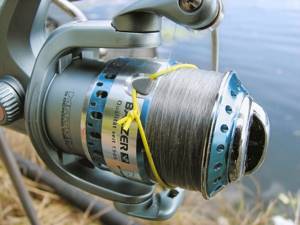
The braid has earned its recognition thanks to the material and special weaving technique using the latest equipment. If you compare the cord and monofilament with the same diameter, then braid is clearly the leader in terms of strength. Thanks to zero elongation, the tackle becomes super sensitive regardless of the distance, which is very important with this method of fishing.
Advantages:
- presence of maximum strength;
- zero stretch;
- long service life with the right approach (2-3 years);
- does not cause difficulties during operation and storage.
Flaws:
- high cost of the product;
- the fibers become shaggy when fishing on rocky places and in snags;
- requires a high-quality reel and perfectly smooth guide rings.
Despite its high cost, the braided line quickly pays for itself. And high strength maintains the integrity of the bait even with a dead hook (unbends hooks on wobblers and spinners).
In order for the guide rings on the fishing rod to serve for a long time and reliably in combination with braided fishing line, they must have silicon carbide inserts.
Otherwise, low-quality rings will soon become unusable (the braid will simply fray them).
Types of spinning lines
The best fishing line for spinning is different for each angler. However, for beginners it will be useful to know how fishing lines differ according to the material they are made of. There are only 3 such varieties:
Monofilament line
This is the simplest smooth nylon thread with a round cross-section. It is used as a main or leader line. Monofilament fishing line is installed mainly on a spinning rod used as a casting rod. Also used for catching predators in the absence of braided cord. It justifies itself in cases where increased strength characteristics are not required, and casting range is not critically important.
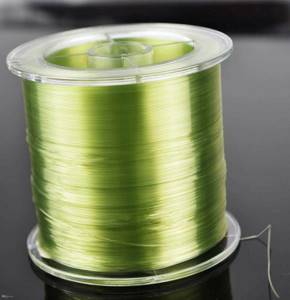
Monofilament fishing line is most often used on spinning rods
Advantages of monofilament:
- Has minimal resistance in water.
- Due to its smoothness, it easily comes off the reel, maintaining the integrity of the guide rings.
- It is transparent, which allows it to camouflage itself in the water column.
- Due to its stretchability, it dampens the jerks of large fish, as a result of which the rod lasts much longer.
- The price of monofilament is significantly less than that of braided thread.
Disadvantages of monofilament:
- Compared to braided cord, it has less strength.
- When fishing over long distances, it has reduced sensitivity to bites.
- It often gets tangled, forming beards, and is difficult to untangle.
- Its shelf life is limited. Over time it loses its strength.
Network
This material consists of polyethylene threads woven together. The resulting cord, having a diameter comparable to monofilament, is an order of magnitude superior to it in strength. Braided fishing line has proven itself best for spinning fishing over long distances. It is extremely sensitive when catching any fish.
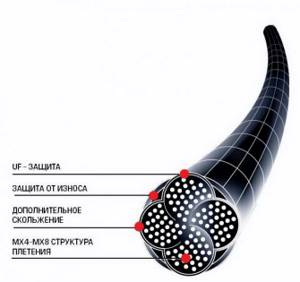
Composition of braided fishing line JigLine
Advantages of braid:
- Has zero stretch.
- Does not curl, does not form beards.
- The braid has very high strength.
- Does not deteriorate during storage.
- If handled properly, it can last 2-3 seasons.
Disadvantages of braid:
- When fishing in snags, on a rocky or shell bottom, the strength of the line may be reduced due to the impact of abrasive particles on it. The fishing line becomes “terry”.
- You need a reel with aluminum spools, since the cord can quickly cut through a plastic spool.
- The rings on the spinning rod must have high-quality inserts that are resistant to the effects of braid.
- The line is not transparent, so the fish can see it.
- The cost of the cord is significantly higher than the price of monofilament.
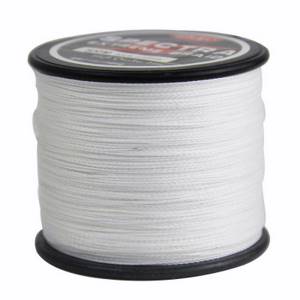
Super Dyneema Saratoga Spectra Braid
Flucarbon line
This is a new product on the fishing market. Fluorocarbon fishing line for spinning rods is made from PVDF polymer. This material is resistant to high and low temperatures (-4-+160 degrees), chemicals and aggressive substances, and is not afraid of UV radiation. Flucarbon is not subject to aging, drying out, deformation and wear. The material has not yet found widespread use among fishermen due to its very high cost.
Advantages of fluorocarbon fishing line:
- Stealth in water. The refractive index of light of the fishing line is almost the same as that of water.
- Doesn't stretch like regular monofilament.
- Increased sensitivity to bites.
- The material is abrasion resistant even when used with conventional metal rings.
- Sinks quickly in water. It has been noticed that it sinks into water 2.5 times faster than nylon fishing line. It does not blow away even when making long casts in strong winds.
Disadvantages of fluorocarbon line:
- High price.
- Increased rigidity. This reduces the strength of the knots being tied. Sometimes anglers have to further strengthen the knots by gluing them.
- Increased fragility of fishing line.
- The breaking load is less than that of monofilament with the same diameters.
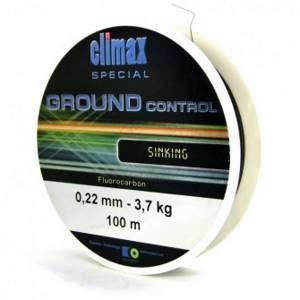
Fluorocarbon line Climax GROUND CONTROL
Sometimes there are difficulties with purchasing fluorocarbon fishing line, since it looks very similar to regular monofilament. To check the composition of the fishing line, you need to bring a burning match to its tip. If the tip melts and begins to curl, then you have a regular fishing line in front of you. If it chars, forming a black dense ball, then you are dealing with fluorocarbon.
Fluorocarbon
Fluorocarbon fishing line is most often used as a material for leashes. But when applied to spinning fishing, it quite successfully copes with all the functions of the main one.
Advantages:
- sensitivity to bites;
- invisibility to the eyes of a predator;
- high resistance to ultraviolet radiation and moisture;
- is not afraid of sudden changes in temperature, which allows it to be used in winter;
- does not stretch;
- resistance to abrasion on aggressive surfaces.
Flaws:
- has a low breaking load relative to nylon mono with a similar diameter;
- high cost of the product;
- Most of the produced fluorocarbon fishing lines are distinguished by their rigidity, which leads to their fragility during operation;
- knots made from such a thread are not entirely reliable; they have to be fixed with superglue.
Monoleskies
Monofoles all over the world are made from various nylon copolymers by extrusion. The quality of the fishing line is determined by the composition of the material, its processing technology, the accuracy of its calibration and a number of other factors. The range of monofilaments is quite wide, in this regard, I will try to give only a general description of the most high-quality of them:
High strength (modern high-quality fishing line with a diameter of 0.2 mm can withstand tensile strength of almost 4 kg; 0.25 - approximately 6 kg; 0.3 - already about 9 kg.
The monofilament is elastic, that is, before it breaks, it stretches, further absorbing the jerks of the fish. Increased abrasion resistance when fishing on reservoirs with a rocky and snagy bottom, that is, the fishing line lasts a long time, gradually losing strength.
The low coefficient of friction ensures long flight of the bait. Some brands of fishing line even have a surface layer containing specially introduced fluoroplastic molecules that reduce friction.
Monofoles are transparent and barely visible in water (except for the special fluorescent colors). Made from nylon-containing polymers, all fishing lines age over time under the influence of water, sun and temperature changes, which is why there are concepts of “new” and “old” fishing line. If the fishing line has lain for more than 2-3 years outside the refrigerator, its strength can be safely divided by 3, or even 5. When drying, the monofilament deforms itself on the reel. Over time, the internal coils become ribbed and lose strength.
Mono lines have a strictly circular cross-section, calibration accuracy reaches thousandths of a millimeter, as a result of which the line is laid evenly on the reel, turn to turn.
Most monofilaments are sinking, since their material has a density greater than that of water.
They work great at sub-zero temperatures; ice does not freeze on them.
The price range for monofilament ranges from 0.5 to a maximum of 5-7 dollars per 100 meters.
What diameter is needed for a spinning rod?
The thickness of the fishing thread must be selected taking into account the following conditions:
- depending on the size of the intended object of fishing (monoline with a diameter of 0.2 - 0.25 mm or braided cord with similar qualities will be relevant for hunting pike, pike perch, small perch);
- depending on the nature of a particular reservoir (for clean places, a thin line is suitable, and in difficult areas it is better to use denser versions of products);
- depending on the reel on the rod (when the spool is completely filled, a full long cast is made).
Diameter or thickness of spinning line
The smaller the diameter of the thread, the further you can throw the bait. Also, a thin line is less easily carried away by the current, so it is more convenient to fish with it on the river.
In addition, with a small diameter, it is less visible to fish, but the visibility of the main line, contrary to popular belief, has little effect on the number of bites in a spinning rod.
The thread should be selected not by diameter, but by breaking load, based on the size of the expected trophies and fishing conditions.
You need to focus on real tensile load indicators, and not on the numbers written on the packaging - manufacturers almost always overestimate them. Of two brands with the same actual breaking strength and other characteristics, the thinner one is preferable.
The larger and stronger the fish you expect to catch, the stronger the line should be. In addition, it is worth taking a larger thickness if you have to fish in difficult conditions - for example, among thickets of grass or snags. For guiding through areas with a clean sandy bottom, the smallest diameters are suitable.
The best manufacturers
The leading manufacturers of fishing lines, according to experienced fishermen, are:
- Braids from Shimano (Beast master), Salmo (Diamond Braid), Steel Power Asama, Sun line Deep one.
- Monofilament from Phantom Line (Super Soft), Shimano (Technium Spinning Line, Antares Silk Shock), Balsax (RXR Kameleon).
As each spinner acquires the appropriate skills, his own priority companies appear. In order not to get into trouble, but to buy a really high-quality fishing thread, you need to check it for breaking in the store.
Pike hunting
Which spinning line should you choose when fishing for pike or other predatory fish? The most popular fishing line diameter is 0.2 millimeters. It is best to take a thread of dark green or brown color. When jig fishing, you should give preference to braided line. If you use a spinner, a spinner and spoons, then take a monofilament line with a thickness of 0.3–0.4 millimeters. Many manufacturers of spinning lines write on the packaging information that this product is suitable for pike fishing.
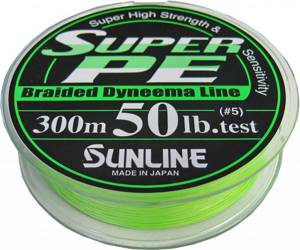
Which fishing line to choose for light spinning rod?
A light spinning rod is rightfully considered a universal tool for the modern fisherman. It is perfect for fishing in small water areas using light baits and on lakes and rivers using wobblers, spinners and spinners.
Considering that the permissible weight of baits varies from 3 to 14 grams, the suitable diameter is up to 0.25 mm (as a rule, 0.18 - 0.2 mm or braid with a thickness of 0.1 - 0.13 mm is used).
A properly selected fishing line for a spinning rod largely determines the success of the upcoming fishing trip.
Prices for fishing lines for spinning
The cheapest fishing line for spinning is monofilament; prices for a spool with 100 meters of such thread start at approximately 70 rubles. But a good monofilament costs much more, and the price of a modern high-quality monofilament line, designed specifically for spinning fishing, reaches 700 or more rubles per 100 meters.
A cheap braided line 135 m long will cost at least 400 rubles. For more expensive brands, this figure reaches 2000 or more rubles. Braid is worth the money and, if used correctly, will last quite a long time, so it fully justifies its price, and you should not save on the purchase of such an important element of spinning tackle as fishing line.
The price of 100 meters of fluorocarbon is about 350-1500 rubles, 150 meters can be bought for 500 rubles or more. Fluorocarbon leader line, which is sold in reels of 20 meters or more, will cost 100 or more rubles per reel.
